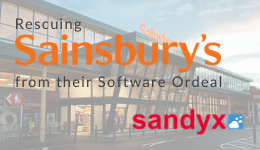
Developing a mobile app is pretty much a given if you want your business to succeed online, especially if your trade involves e-commerce or B2B.
But what's the best way to do that? Is there such a thing as a piece of software that can save time, money, and delays on the build, regardless of what your business is? While there’s no such equivalent as a magic wand that you can cast over the app-building process, there is something close: a cross-platform framework.
But what is a cross-platform mobile framework? What does it do? Which is the best one to use for your business's mobile app, and are there any downsides?
Let’s take a look, shall we?
What is a cross-platform framework?
A cross-platform app framework is a software framework that allows app development agencies like Foresight Mobile to build mobile applications that can run on multiple operating systems using a single codebase. What that means in English is that we don’t need to write separate codebases for each platform (iOS, Android, Web), which makes the development phase a lot quicker and saves time, money, and stress for everyone involved.
So, now that we’ve got that established, which is the best cross-platform framework to use?
Hold on, eager beaver, we’re getting to that!
What are the 5 best cross-platform frameworks to use?
This will depend on your specific needs and preferences. That being said, here’s a rundown of five of the most popular cross-platform frameworks and what they have to offer.
Flutter
Used by the likes of Google, Alibaba, and Uber, Flutter is a free, open-source framework developed by Google. It uses its own engine, Skia, to render widgets directly on the device, which results in high-performance and native-looking apps. Flutter is a great choice if you want your app to be slick and have a truly modern UI. The number of Flutter-based apps surpassed 1 million earlier this year, more than doubling the previous amount, so it’s a platform that’s on the rise.
React Native
React Native is a JavaScript framework that uses Facebook's React library to build user interfaces. It allows us to write code in JavaScript, which then gets translated into native widgets on the device. We’ve been working with React Native for years, and we’re big fans of its flexibility, as are Facebook, Skype, Walmart, and Wix, who all have apps based on the framework. But like a lot of platforms, it’s faced certain operational challenges recently that only serve to highlight the importance of hiring a skilled and versatile development team like Foresight Mobile.
Xamarin
This is Microsoft’s framework that uses the C# programming language to build native iOS and Android apps. It allows us as developers to share a significant amount of code between the two platforms, which can save time and money. The other good thing about Xamarin is that it's got a HUGE support community, so if there’s anything we don't know the answer to, we can find out in double-quick time. The big downside is that the UI is very limited to 'forms', which is great for a business app but will fall short of expectations for consumer-grade UI.
Ionic
Ionic uses web technologies like HTML, CSS, and JavaScript to build hybrid mobile apps. It’s been a cross-platform player for over a decade, but due to the emergence of platforms like Flutter, its popularity is waning, and its plugins aren’t being maintained like they were in the past. For those with simple use cases and an existing web team, Ionic can make some sense, but the maintenance burden can be very high compared with Flutter and React Native.
Kotlin Multiplatform
This relative newcomer has gained some traction over the last few months. Though it’s not possible to write any of your iOS front-end code using Kotlin, you may be able to share some of your business logic between iOS and Android. For some services that have built Android-first, this may be a viable option, reducing development time on your new iOS build. For the majority of API-driven apps, the benefits are marginal however, and even the best-architected Android apps will require significant refactoring to get to the point where business logic can be shared.
What are the pros and cons of using cross-platform mobile frameworks?
As with all technologies, there are pros and cons to using cross-platform mobile frameworks, so let’s investigate those in closer detail:
Pros of cross-platform frameworks
Reduced development time and cost
A major advantage of cross-platform frameworks is the ability to write a single codebase that can be deployed on multiple platforms. This eliminates the need to develop separate codebases for iOS and Android, saving time and money.
Faster time to market
With a single codebase, you can release your app to multiple platforms simultaneously, reaching a wider audience more quickly. This can be a significant advantage for businesses that need to get their app to market quickly.
Simplified maintenance and updates
Maintaining and updating multiple native codebases can be a complex and time-consuming process. Cross-platform frameworks simplify this process by allowing you to maintain and make changes to a single codebase that will be reflected across all platforms. You’re also recruiting for one tech stack instead of two, vastly reducing operating costs.
Consistent user experience
You’ll get a consistent user experience across different platforms, regardless of the device or operating system. This is crucial for maintaining brand consistency and providing a seamless user experience for all app users.
Scalability and future-proofing
They’re designed to be scalable, making it easier to adapt and extend your app to new platforms. This future-proofs your investment, and in the case of Flutter, allows you to target the web easily if your business requires it.
Access to a larger developer pool
The popularity of cross-platform frameworks has led to a growing pool of developers experienced in using these tools, making it easier and cheaper for businesses to find qualified developers to build and maintain their cross-platform apps.
Reduced reliance on Native platform SDKs
Cross-platform frameworks often provide their own abstraction layer, reducing the need to rely on native platform SDKs. This can simplify development and make apps less dependent on specific platform versions.
Cons of Cross-Platform Frameworks
Hardware integration
Although native integration has improved significantly for cross-platform frameworks (especially on Flutter through Dart-FFI), some cross-platform apps still find tight hardware integrations, such as Bluetooth or camera support, difficult to incorporate.
Complex apps
While cross-platform frameworks are well-suited for many apps, developing complex applications with intricate UI/UX or demanding performance requirements may be more challenging with cross-platform frameworks.
How do I choose the best mobile app development framework?
The main factor to consider when choosing a mobile app development framework is its popularity and support. In years to come, you’ll want to see that your dependencies are well-maintained and that the companies supporting your framework are actively using it for their own projects.
Google Trends reports are a quick and easy way to gauge interest over time, and as you can see here, Flutter seems to be winning out worldwide. At the time of writing, though, React Native is giving it a run for its money in the UK, so it’ll be interesting to see how that pans out over the coming year.
Reference


If you’re in any doubt about which framework you should be using to develop or refresh your app, book a free consultation with any member of the Foresight Mobile team, and we’ll be glad to advise you. We have years of experience on all of the platforms mentioned above, so give us an idea of your project, and we’ll recommend the best cross-platform mobile framework to turn your business app into a world-beater.







